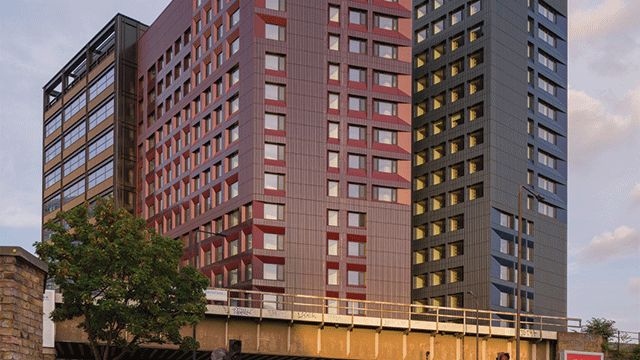Red alert: Long seen as highly resistant to the economic woes that afflict other sectors, industrial property is beginning to show the first signs of tension. EG Capital’s James Wallace reports
Through the rigours of a routine economic cycle, there will always be some sectors more exposed than others to the good and the bad times.
In property’s recent bad times, those sectors that have suffered the most – office, retail and residential – have long been feeling the price-correction pinch.
The industrial sector, by contrast, tends to be seen as the UK’s “Steady Eddy”. Indeed, past performance suggests that the sector has some degree of resilience during recessionary cycles while industrial assets did not benefit from as much capital appreciation as other sectors in recent boom times, rental growth, for instance, did remain positive in the years following the dot.com crash.
However, the industrial market has not proved capable of absorbing macro-economic upheaval on the scale that the credit crunch has presented.
“The UK’s industrial sector is overheated,” admits Paul Edwards, associate director and lead fund manager of Legal & General’s £925m Industrial Property Investment Fund. “We stopped buying industrial assets three years ago. We got the market wrong, if we are brutally honest – the market had two more years of rising capital values to go before the tailoff.”
Price correction in the sector has seen L&G’s fund value fall from a high of £1.05bn last September. “The pace of the subsequent downturn was greater than we anticipated,” Edwards admits. “We now think the market has some way further to fall – we are probably only halfway through the sector’s correction.”
In total, L&G has more than £2.5bn of exposure to UK industrial assets, with “moves afoot” on the prospect of investing in continental Europe, and possibly beyond.
Segro has warned of “a tougher market ahead” for the value of warehouses, offices and shops, as it turns into a “net seller” of UK property. The company is ploughing its money instead into continental European projects, where it expects far swifter gains on capital values than can be found in the UK.
Edwards says: “What we are seeing now is a dearth of quality industrial assets on the market. There are a lot of bargain hunters out there waiting to pounce at a sign of genuine distress among sellers, but the stock is not there yet.”
Transactional volumes over the first quarter of 2008 plummeted to just £495m, down by almost 50% on the same period last year and only one-sixth of the figure for the most active recorded quarter – Q4 2006, when fractionally less than £3bn of industrial assets exchanged hands.
According to Savills, over the nine months since July 2007, about £1.75bn of industrial assets have been brought to the market, of which around 20% have been withdrawn as the vendors chose not to sell, and more than 50% have either sold or is currently under offer.
Tony O’Keefe, industrial associate director at DTZ’s Manchester office, says: “The far-reaching effects of the credit crunch on the industrial market have been most notable in capital markets, where some property funds and developers have effectively halted any further market activity for the short term.
O’Keefe adds: “They are regrouping after the halcyon days of yield compression, which saw increasing confidence in the industrial sector being reflected in rising values. A correction was at some point inevitable.”
Property investment director Mark Watts of Standard Life Investments says: “The price correction and rerating in property was happening irrespective of the credit crunch, which just exacerbated it.
“Since last June, we have been net disinvestors of UK industrial. The problem for industrials was that the yields had contracted too far and, set against the rental growth prospects, it was starting to look expensive.”
Occupier demand, which has been consistent until recently, is now starting to wane. “Development has slowed down,” says Len Rosso, head of logistics and industrial with Colliers CRE. “If that progresses and development dries up, and no-one builds for 18 months to two years and a shortage of supply develops, values will increase quite rapidly.”
Inherently, there are still some positives – unemployment is still very low, and interest rates on a 10- to 15-year cycle are still very low, although Rosso estimates that “real” inflation is running somewhere between 7.5% and 10%. “If we can get through the credit crunch sooner rather than later,” he says, “then it won’t have that consequential knock-on effect on the occupier market.”
Despite Rosso’s anecdotal indication of slowing development, recent research by Colliers suggests that UK industrial average prime rents have reached £7.40 per sq ft, up by 1.8% year-on-year.
The factors behind this rise include an increased focus on environmental performance and market demand for modern facilities, which offer the ability to specify bespoke layouts.
A large number of occupiers seeking high-quality properties with good facilities, but who do not need a brand new building, have kept secondary rents steady at £5.94 per sq ft.
More steady
Banks see industrial assets as intrinsically more steady than other sectors, such as the office sector, where the risk profile is much greater, given higher land values, building costs and rents. Indeed, there are banks out there which are still able, and willing, to leverage against deals.
Edward Daubeney, an associate in Cushman & Wakefield’s capital markets group, says: “The industrial sector is not unlike the other sectors at the moment. Banks are lending on good quality stock with good tenants and decent lease lengths.
“Loan-to-value ratios will not vary on a prime shop and a prime industrial unit. The only difference could be on the amortisation profile, which might be a bit steeper on an industrial unit – but you would hope the yield took that into account.”
Merseyside-based Spencer Holdings is negotiating a £50m extension to its existing £200m revolving senior-debt facility with Bank of Scotland. Two instalments of £100m were negotiated in mid-2005 and December 2007, at a margin of sub-1% over LIBOR.
Christopher Hughes, property director at Spencer Holdings, admits that he is expecting the cost of debt to increase this time around. He says: “They have said to us that, while they are being very cautious with new borrowing, with existing clients, particularly those lowly geared such as ourselves, they are much more accommodating.”
Nicholas Bewes, managing director of the Cambridge-based Howard Property Group, says: “Pressure is already mounting on those highly leveraged players in the market, and many banks are taking a far more demanding and tough stance in negotiating new deals.
Bewes believes that: “It is widely felt that this is likely to continue for some time yet, as banks continue to tighten up their lending criteria and LIBOR levels continue to reflect banks’ reluctance to lend money around the market.”










